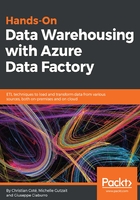
Limitations of ADF V1.0
As good as ADF was, and although a lot of features have been added to it since its GA in 2015, there were a few limitations. At first, we relied on JSON quite a lot to define various ADF abstracts. The number of data stores and compute capabilities were quite limited.
The development experience is very different compared to V2.0. As shown in the following screenshot, we could use the Author and Deploy capability, but it only gave us JSON templates.

As we will see later in this book, the new V2.0 factory has a much better development experience.
When it came to source control, we had to rely on Visual Studio integration. From Visual Studio, we could create or import an existing factory and therefore, use the source control of our choice to version it.